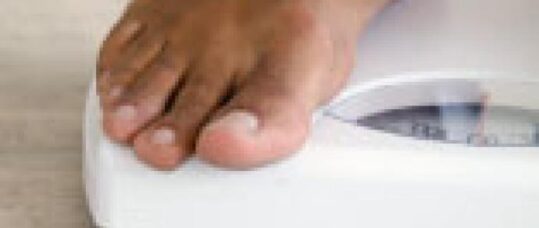Key learning points:
– Recognition of the most common eating disorders
– Signs and symptoms that can be identified
– Groups with a high risk of developing an eating disorder
Eating disorders (EDs) are very debilitating, but understanding of them is still poor – both in the general population and, more worryingly, the medical profession.
First it is important to recognise that all EDs, with the possible exception of rumination disorder, which is relatively rare, have a component of psychological distress to qualify for the diagnosis, in accordance with the Diagnostic and Statistical Manual of Mental Disorders, Fifth Edition (DSM-5).
It is also worth noting that the forms of disordered eating patterns that fall outside DSM-5 still deserve attention. Serious life-threatening consequences can ensue if they are not treated. Research shows that early detection of EDs and disordered eating patterns yield significantly better outcomes for patients. Timely diagnosis and signposting to treatment options is paramount, not only for the individual’s wellbeing but for the most effective deployment of health resources. This article will highlight how to recognise signs/symptoms of the various EDs, diagnostic criteria of the EDs you are most likely to encounter in primary care and how to identify those who are most at risk of developing an ED.
Identifying Eating Disorders
“Nearly half of all EDs may go undetected.”1 “This underscores the importance of screening for EDs as a part of routine assessment in primary care.”2 Nurses are at the very coal face where these debilitating disorders can be recognised, since this is where patients tend to first present, albeit with other medical concerns. The primary care nurse almost has to be a sleuth, as the presentation may be of a gynaecological, gastroenterological, dermatological, psychological or other nature. However, the symptoms might be a mask for the incipient development of an ED.
EDs tend to be shrouded in secrecy, denial and shame because of the negative public perception of them as ‘self-inflicted’. Patients may feel undeserving of help or wary of disclosing them for fear of courting judgment and censure. But most importantly, an ED sufferer cannot envisage life without this outlet for their emotional pain. As a consequence, sufferers experience conflict. They desire to be released from the demands of the condition, which is clearly damaging many aspects of their life, not least their physical, psychological and emotional health. But they do not know how they might cope without the temporary emotional release that the disorder gives them. Having an ED can feel like an intricate dance between love and hate – dependency on the condition and a desire to be liberated.
In this sense an ED is a form of self-harm, a way for the sufferer to cope and continue to live, despite being aware of and devastated by the pain and anguish they cause to family, friends and themselves. So it is easy to see why patients with an ED must be handled with great sensitivity and empathy to let them be open and honest about their experience. This will only happen if the health professional has managed to create a trusting environment.
For the reasons cited, identifying an ED can be tricky enough in the first place. But this is further compounded by the fact that physical symptoms often do not arise until the disorder is deeply established. Therefore it is imperative that health professionals remain keenly alert for the mildest of signs and symptoms.
Signs and symptoms
Signs and symptoms of EDs are numerous and varied, manifesting themselves in the physical, psychological, emotional and behavioural domains. Nurses need to be vigilant to spot these indicators, which include the following:
Physical
Dehydration; amenorrhea; fertility problems; severe weight fluctuations, gains and losses; swollen cheeks and neck; abdominal pain; constipation; bloating; broken blood vessels in eyes and on face; sore throat; reflux; heartburn; calluses on knuckles and the back of hands; lanugo; dull, dry and thinning hair; dry nails; gingivitis; discolouration of teeth; enlarged salivary glands; dental decay; yellowish tinge to skin or pale appearance; dry skin, acne and xerosis; hypothermia and intolerance to cold; injuries including self-harm; fatigue, fainting and light-headedness; weak, irregular pulse; chest pain, arrhythmias and bradycardia, dyspnoea.
Psychological/emotional
Feelings of guilt, shame, embarrassment; depression; anxiety; intense fear of gaining weight; distorted body image; low self-esteem; self-criticism; self-loathing; denial of low weight; mood swings; denial of hunger.
Behavioural
Bingeing; purging – abuse of laxatives, diet pills, enemas, diuretics; compulsive over-exercising; secretive eating; sense of lack of control over eating; missing meals; hiding food; eating alone; self-medicating with food; lies and excuses about eating; engaging in food rituals; withdrawal from friends; avoidance of activities, particularly those that involve eating; eating until uncomfortable or painfully full; eating even when not physically hungry; poor sleep.
Detecting and diagnosing
Detecting EDs before the more obvious clusters of physical symptoms have emerged can be achieved through gaining a thorough patient history and building a rapport. If eliminating the possibility of an ED is to become a routine reality for target groups it is important that simple inexpensive screening tools can be deployed by non-specialised health professionals. “While people may not volunteer information about their eating problems, many would welcome questions regarding their eating behaviour as a first step towards getting help.”3
The tool that has proved to be the most memorable, simple and inexpensive to administer is known as SCOFF, an acronym for five key issues raised in five questions:
1. Do you make yourself ‘sick’ when you feel uncomfortably full?
2. Do you worry that you have lost ‘control’ over how much
you eat?
3. Have you recently lost more than ‘one’ stone in a three-month period?
4. Do you believe yourself to be ‘fat’ when others say you are
too thin?
5. Would you say that ‘food’ dominates your life?
If the patient answers positively to at least two of the questions, further investigations would be appropriate to uncover whether an ED is present and if so which one.
Although these questions are disarmingly simple, they must be delivered with great sensitivity to enable the patient to engage with honesty and confidence. Nurses need excellent communication skills to create the required climate of trust. Other tools used for ED screening include:
– Eating Disorder Screen for Primary care (ESP).
– Questionnaire for Eating Disorder Diagnoses (Q-EDD).
– Eating Attitudes Test (EAT).
– Eating Disorder Inventory (EDI).
Some of these require specialist interpretation and can be laborious to administer. On balance, SCOFF appears to be the most serviceable tool to date.
Further on I have described, in accordance with DSM-5, the diagnostic criteria for the three most common EDs that nurses will encounter in their work: anorexia nervosa (AN), bulimia nervosa (BN), and binge ED (BED).
For a diagnosis of anorexia nervosa (AN) the following three criteria must all be met:
1. The patient must have a significantly lower body weight than would be expected for their developmental stage, age and sex. The result of this deficit, caused by self-induced starvation, compromises the patient’s health.
2. The patient is intensely fearful about the prospect of gaining weight despite being significantly underweight.
3. The patient experiences their shape and weight in a disturbed manner, which plays an overly powerful role in self-evaluation; or the patient is in denial about the dangers of their current low weight.
For a diagnosis of bulimia nervosa (BN) the following five criteria must all be met:
1. The patient must experience repeated episodes of compulsive eating within a short time frame, usually under two hours, in which large quantities of food are consumed. This is known as bingeing and the patient feels out of control while doing this.
2. The patient will indulge in repeated inappropriate compensatory behaviour to prevent further weight gain caused by the food consumed. This purging may take the form of self-induced vomiting, misuse of enemas, diuretics and laxatives or excessive over-exercising.
3. The above behaviours of bingeing and compensatory behaviour must occur at least once a week for a minimum of three months.
4. The patient’s self-evaluation is inordinately focused on their weight and body shape.
5. The disturbance does not occur exclusively during episodes
of AN.
For a diagnosis of binge ED (BED) the following five criteria
must all be met:
1. The patient must experience repeated episodes of bingeing excessive quantities of food while feeling totally out of control, incapable of limiting the quantity consumed or stopping.
2. These episodes must be associated with at least three of the following: eating until uncomfortably full, bingeing when not feeling physically hungry, eating faster than is normal, eating alone due to embarrassment over the excessive amount consumed, experiencing feelings of self-disgust and depression while consuming the food or intense guilt after eating.
3. The patient experiences considerable distress about the bingeing.
4. Bingeing occurs, on average, at least once a week for three months.
5. There is no repeated use of inappropriate compensatory behaviours to get rid of the food or its effects. The bingeing does not occur exclusively during the course of AN, BN or avoidant/restrictive food intake disorder (ARFID).
It is important to note that the DSM-5 lists several other EDs that are less common but can be equally debilitating if left undiagnosed. These are: rumination disorder, pica, avoidant/restrictive food intake disorder (ARFID), other specified feeding or ED (OSFED) and unspecified feeding or ED (UFED).
In addition, nurses are likely to encounter patients who exhibit signs and symptoms of other problem eating habits that have become apparent in recent years. These are: orthorexia, bigorexia, drunkorexia and pregorexia. All these conditions and disorders, if allowed to escalate, can have serious consequences for the patient. As always, the earlier the interventions are applied, the better the prognosis.
When time and resources are stretched it is even more important that nurses are aware of the groups who have a higher risk of developing an ED.
Traditionally, EDs were chiefly found in the young, white, female population. Today, males and minority ethnic groups are increasingly susceptible to EDs, as are an increasingly younger and older female demographic. Those who have been identified as at higher risk are:
– Young people between 12 and 25 years of age.
– People with a family history of EDs.
– People with a high body mass index currently or in childhood.
– Dieters.
– Women with polycystic ovary syndrome.
– Diabetics.
– Women going through pregnancy or menopause.
– People who have been exposed to bullying about their appearance.
– People from occupations where body shape and weight is scrutinised such as models, actors, ice-skaters, dancers (particularly ballet) and athletes.
Conclusion
Whenever practicable, nurses should endeavour to eliminate the possibility of an ED with all their patients but most particularly in the high-risk groups.
Nurses need to be permanently aware of the possibility of an ED and approach all patients with empathy and compassion, since gaining the patient’s confidence is everything in achieving successful outcomes.4
References
1. Pritts SD, Susman J. Diagnosis of EDs in primary care. American Family Physician 2003;67(2):297-304.
2. Kondo DG, Sokol MS. Eating disorders in primary care: a guide to identification and treatment. Postgraduate Medicine 2006;119(3):59-65.
3. National Eating Disorder Collaboration. Identifying people at risk of EDs. nedc.com.au/identifying-people-at-risk (accessed 26 April 2016).
4. The British Psychological Society & The Royal College of Psychiatrists. Identification of EDs in primary care, 2004. ncbi.nlm.nih.gov/books/NBK49312/ (accessed 26 April 2016).







